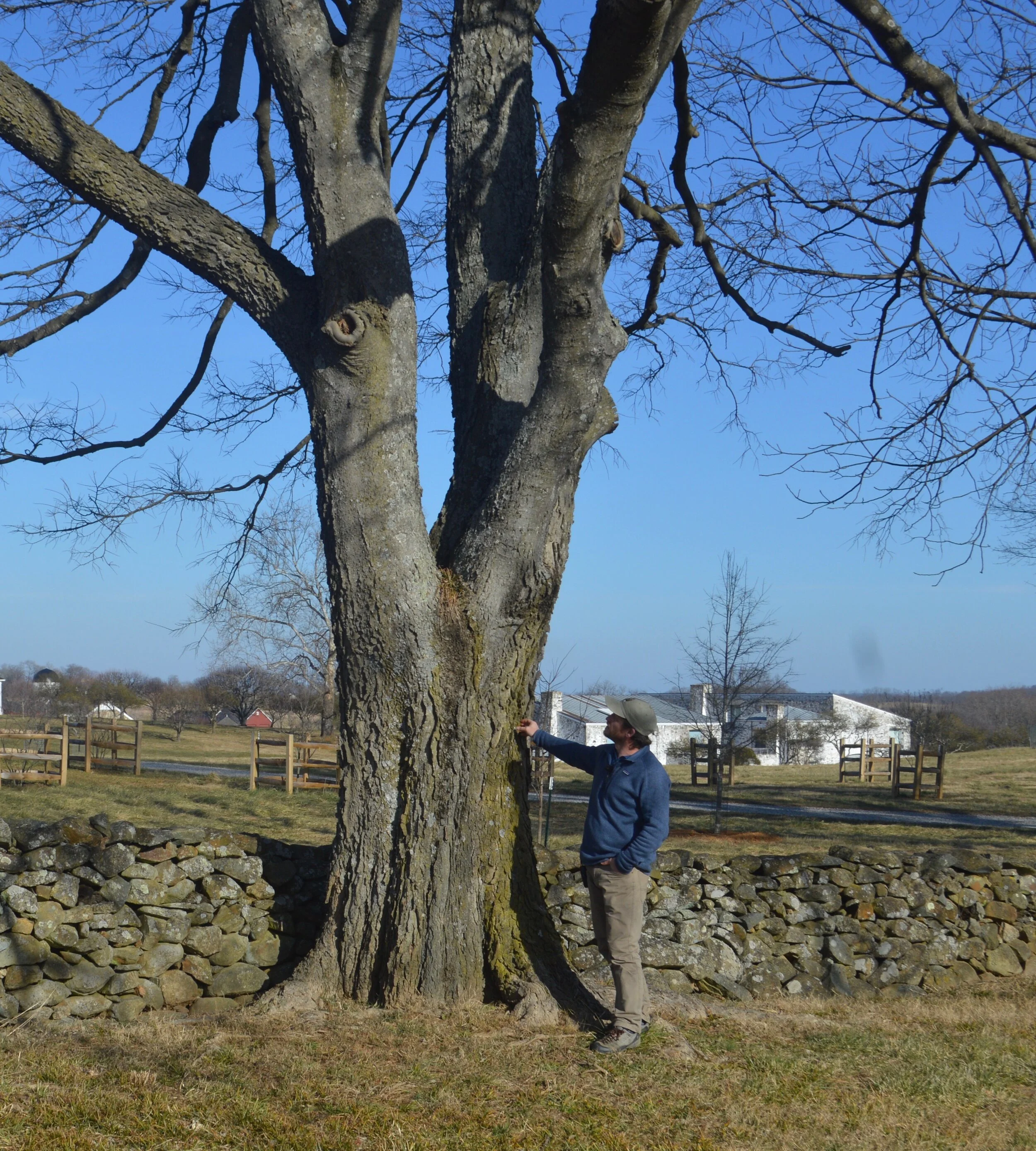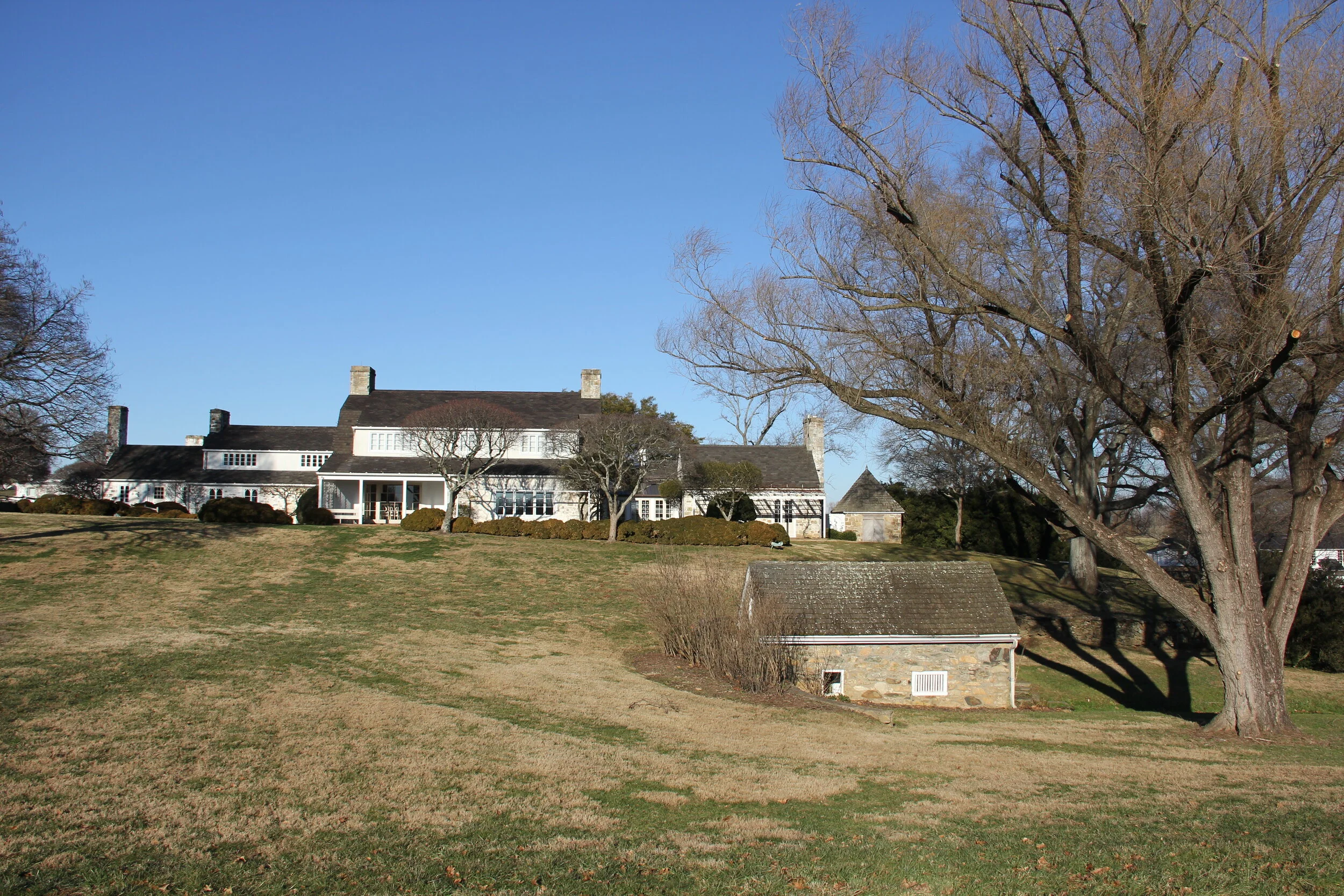Reading Peach Tree Lane
Emily Ellis
Leading from Rokeby Road to Oak Spring’s Main Residence is a slightly sunken grassy path with the incongruous name, “Peach Tree Lane.” Although no fruit trees line what was likely named after a former neighbor with the surname “Peach,” the lane has been an important feature of the property since the 1800s, providing passage for people and animals alike and providing important clues about the history of the land that OSGF has the privilege of caring for today.
1903 survey of the Oak Spring property. Compliments of Michael Gaige.
Peach Tree Lane is one of the many features of Oak Spring that has been surveyed and researched by ecologist Michael Gaige, the author of two extensive landscape surveys of the Oak Spring and Rokeby properties and the leader of our annual “Reading the Landscape” short course.
Continuing to delve into the long, complex history of Oak Spring not only helps us to understand the human and non-human history of the site, but to learn to better acknowledge those histories and manage the land sustainably in the present - which is why we’re thrilled to welcome Michael back to Oak Spring in April for another run of his popular “Reading the Landscape” course. This field course, designed for professionals and advanced students interested in gaining experience in interpreting landscape history, will run from April 15 to May 1, and will consist of five remote lectures via Zoom as well as two outdoor field days at and around Oak Spring. The application deadline is March 12; more details and applications can be found here.
Interested in learning more about landscape interpretation? Watch the video below to take a wintery stroll along Peach Tree Lane with Michael, and scroll down to read a little about several of the landscape features he discusses in the video.
Stone Walls
Many stone walls at Oak Spring were topped by American chestnut rails in order to meet the height requirement for livestock fencing. The American chestnut succumbed to a blight in the early 1900s, and all the rails seen at Oak Spring are at least 100 years old.
One of the most notable features of Peach Tree Lane is the dry-stacked stone wall running alongside it. Northern Virginia is one of the three areas of the country with high concentrations of stone walls, the other two being New England and the Kentucky bluegrass region; the Peach Tree Lane wall is among the six miles of stacked stone on both the Rokeby and Oak Spring properties.
These stone walls, built from the settlement period up to when the Mellon family owned the property from the 1930s onward, took a tremendous amount of skill and labor to erect. If gathered together and piled to knee height, they would cover a staggering five acres - a way to imagine the time and work that went into the stacking and collection of the stones over the decades.
The chestnut round pictured here was used as a guide to build the wall to the correct width.
While the newer stone walls on the property were cut and fitted by masons during the Mellon era, the dry-stacked wall on Peach Tree Lane was first built of rounded field stones in the 1800s, with some sections likely having been re-stacked in more modern times. These stones were dug out of the earth - probably from the adjacent field, which was used for agriculture in the mid-1800s - and stacked as they were (see more about Oak Spring’s stone walls in An Oak Spring Landscape, page 142).
The stone wall on Peach Tree Lane also stands as a reminder of a dark side of Oak Spring’s history that is important to acknowledge. It’s likely that enslaved people dug the stones and built the wall; in the-mid 1800s, there were 24 enslaved people on the Rokeby property (then owned by Nathan Loughborough) according to a 1860 slave census (see Rokeby: A Landscape Biography, page 33). While Michael was unable to find such a census for the Oak Spring property, five enslaved people were named in Robert Fletcher’s 1841 will: Girl Catherine and daughter Mary Ellen, Boy James, Charlotte, Mountain Henry, and Billy. It is possible that they worked to erect the wall around that time.
Trees
In the wintertime, hackberries are distinguishable by their furrow-like bark.
Have you ever wondered why some tree species are more commonly seen alongside stones walls than others? Mostly, it has to do with how tasty they are to birds. Hackberries, like this one on Peach Tree Lane, are often found along old stone walls because birds are fond of their deep purple berries. The birds perch on stone walls, deposit seeds from the berries, and many decades later a sturdy hackberry has established itself (hackberries are also deer-resistant, another reason why they are able to survive along stonewalls in Northern Virginia). Other trees commonly found along stonewalls and old fence lines include black walnut, black cherry, and ash.
Main Residence
This image was provided by grandson of Tacy Glascock Fletcher Slater, a previous owner of Oak Spring
The beautiful, H. Page Cross-designed Main Residence was erected in 1951, but there used to be a far humbler home in that exact location. Robert Fletcher, whose family settled in the area in the late 1700s, established himself on what is now Oak Spring by the 1820s, building a chestnut log cabin in the exact footprint of the Mellon’s main residence (see An Oak Spring Landscape, page 8, for more on the history of ownership of Oak Spring). The Fletcher cabin, which was relocated across the road before the Mellon’s home was constructed, now sits on a neighbor’s property.
Peach Tree Lane would have served as a track for horse or carriage to reach the cabin, perhaps serving as a direct path for visiting neighbors on what is now Rokeby - much as it is used today for our resident artists and scholars to reach Main Residence from their accommodation on the Rokeby side.
Interested in learning more about the history of Oak Spring and Rokeby? Free, digital editions of Michael Gaige’s surveys of the property can be found online at issuu.com.
Banner image by Autumn Von Plinksy






